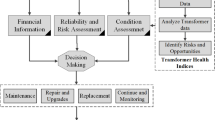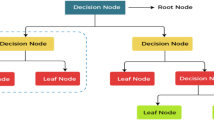Abstract
Condition monitoring of power transformers is of vital importance to prevent electricity supply stoppages and reduce power plant maintenance costs. To that end, the use of techniques to evaluate and classify the condition of these devices is highly recommended in order to obtain good quality information for their proper maintenance planning. This article presents and details a general methodology for the creation of methods to evaluate and classify these devices, by means of computational modeling and optimization. The results indicate a higher than 93% accuracy rate compared to that of numerical evaluations and symbolic classifications expected by experts, thus demonstrating the applicability of the proposed methodology, which is found to be superior in comparisons against Computational Intelligence and Statistical Learning methods.


Similar content being viewed by others
References
Abu-Elanien, A. E., Salama, M. M., & Ibrahim, M. (2012). Calculation of a health index for oil-immersed transformers rated under 69 kV using fuzzy logic. IEEE Transactions on Power Delivery, 27(4), 2029–2036.
Ashkezari, A. D., Ma, H., Saha, T. K., & Ekanayake, C. (2013). Application of fuzzy support vector machine for determining the health index of the insulation system of in-service power transformers. IEEE Transactions on Dielectrics and Electrical Insulation, 20(3), 965–973.
Barbosa, F. R., Almeida, O. M., Braga, A. P., Amora, M. A., & Cartaxo, S. J. (2012). Application of an artificial neural network in the use of physicochemical properties as a low cost proxy of power transformers DGA data. IEEE Transactions on Dielectrics and Electrical Insulation, 19(1), 239–246.
Chen, L. J., Lin, W. M., Tsao, T. P., & Lin, Y. H. (2007). Study of partial discharge measurement in power equipment using acoustic technique and wavelet transform. IEEE Transactions on Power Delivery, 22(3), 1575–1580.
Contin, A. (2015). Diagnostics of insulation systems by means of partial discharge. In 10th international symposium on diagnostics for electrical machines, power electronics and drives (SDEMPED), 2015, IEEE, Guarda (pp. 191–197).
Duval, M., & Lamarre, L. (2014). The Duval Pentagon – a new complementary tool for the interpretation of dissolved gas analysis in transformers. IEEE Electrical Insulation Magazine, 30(6), 9–12.
Engelbrecht, A. P. (2007). Computational intelligence—An introduction (2nd ed.). Hoboken: Wiley.
Hooshmand, R. A., Parastegari, M., & Forghani, Z. (2012). Adaptive neuro-fuzzy inference system approach for simultaneous diagnosis of the type and location of faults in power transformers. IEEE Electrical Insulation Magazine, 28(5), 32–42.
IEEE Guide for the Detection of Acoustic Emissions from Partial Discharges in Oil-Immersed Power Transformers. (2000) In IEEE Std C57.127-2000 (pp. 1–24).
IEEE Guide for Diagnostic Field Testing of Fluid-Filled Power Transformers, Regulators, and Reactors. (2013) In IEEE Std C57.152-2013 (pp. 1–121).
IEEE Recommended Practice for Partial Discharge Measurement in Liquid-Filled Power Transformers and Shunt Reactors. (2010) In IEEE Std C57.113-2010 (Revision of IEEE Std C57.113-1991) (pp. 1–47).
International Electrotechnical Commission - IEC. (2007) Mineral Oil-Impregnated Electrical Equipment in Service-Guide to the Interpretation of Dissolved and Free Gases Analysis, IEC Publication 60599.
Jahromi, A., Piercy, R., Cress, S., Service, J., & Fan, W. (2009). An approach to power transformer asset management using health index. IEEE Electrical Insulation Magazine, 25(2), 20–34.
Li, J., Zhang, Q., Wang, K., Wang, J., Zhou, T., & Zhang, Y. (2016). Optimal dissolved gas ratios selected by genetic algorithm for power transformer fault diagnosis based on support vector machine. IEEE Transactions on Dielectrics and Electrical Insulation, 23(2), 1198–1206.
Marques, A. P., Dias, Y. A., Moura, N. K., Ribeiro, C. J., Rocha, A. S., Azevedo, C. H., et al. (2018). Method for optimized analysis of electrical tests of insulation power factor in power transformers. IEEE Latin America Transactions, 16(3), 823–828.
Marques, A. P., Moura, N. K., Dias, Y. A., Ribeiro, C. J., Rocha, A. S., Brito, L. C., et al. (2017a). Method for the evaluation and classification of power transformer insulating oil based on physicochemical analyses. IEEE Electrical Insulation Magazine, 33, 39–49.
Marques, A. P., Moura, N. K., Ribeiro, C. J., Dias, Y. A., Rodrigues, A., Rocha, A. S., Azevedo, C. H., Santos, J. A., Sousa, F. C., & Brito, L. C. (2017). Insulation resistance of power transformers—Method for optimized analysis. In 19th IEEE international conference on dielectric liquids – ICDL. Manchester, United Kingdom.
Marques, A. P., Ribeiro, C. J., Azevedo, C. H., Santos, J. A., Sousa, F. R., & Brito, L. C. (2014). Power transformer disruptions- a case study. IEEE Electrical Insulation Magazine, 30(2), 17–21.
Marques, A. P., Sousa, F. R., Brito, L. C., Ribeiro, C. J., Azevedo, C. H., Santos, J. A. (2015) A mathematical contribution to the analysis of moisture migration in power transformer oil-paper insulation systems. In IEEE 10th International Symposium on Diagnostics for Electrical Machines, Power Electronics and Drives (SDEMPED), 2015, Guarda (pp. 1–6).
Michalewicz, Z., & Fogel, D. B. (2004). How to solve it: Modern heuristics (2nd ed.). Berlin: Springer.
Moulai, H., et al. (2010). Physico-chemical properties of power transformer oil mixtures. In 15th IEEE mediterranean electrotechnical conference Melecon 2010, Valletta, 2010 (pp. 1105–1110).
Press, W. H., Teukolsky, S. A., Vetterling, W. T., & Flannery, B. P. (2007). Numerical recipes: The art of scientific computing (3rd ed.). New York: Cambridge University Press.
Singh, S., & Bandyopadhyay, M. N. (2010). Dissolved gas analysis technique for incipient fault diagnosis in power transformers: A bibliographic survey. IEEE Electrical Insulation Magazine, 26(6), 41–46.
Acknowledgements
The authors thank the Federal University of Goiás and the Federal Institute of Education, Science, and Technology of Goiás for their practical support, as well as the Goiás State Research Foundation (FAPEG) and the Brazilian Electricity Regulatory Agency (ANEEL) for their financial support of this work.
Author information
Authors and Affiliations
Corresponding author
Additional information
Publisher’s Note
Springer Nature remains neutral with regard to jurisdictional claims in published maps and institutional affiliations.
Appendices
Appendix A: Physicochemical Evaluation and Classification Method
The results of the optimization of evaluation and classification model with respect to physicochemical parameters (Marques et al. 2017a) are presented in Table 2.
Appendix B: Electrical Evaluation and Classification Method
The results of the optimization of evaluation and classification model with respect to insulation resistance parameters (Marques 2017b) are presented in Table 3.
The results of the optimization of evaluation and classification model with respect to power factor parameters (Marques et al. 2018) are presented in Table 4.
Rights and permissions
About this article
Cite this article
da Cunha Brito, L., Marques, A.P., de Jesus Ribeiro, C. et al. A General Methodology for Evaluation and Classification of Oil-Immersed Power Transformers: Application to Electrical and Physicochemical Parameters. J Control Autom Electr Syst 30, 832–839 (2019). https://doi.org/10.1007/s40313-019-00487-6
Received:
Revised:
Accepted:
Published:
Issue Date:
DOI: https://doi.org/10.1007/s40313-019-00487-6




